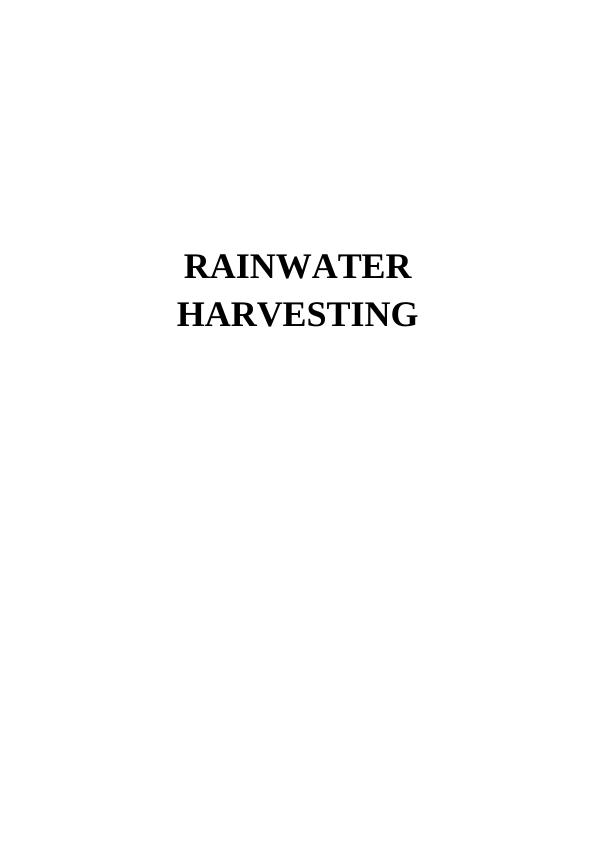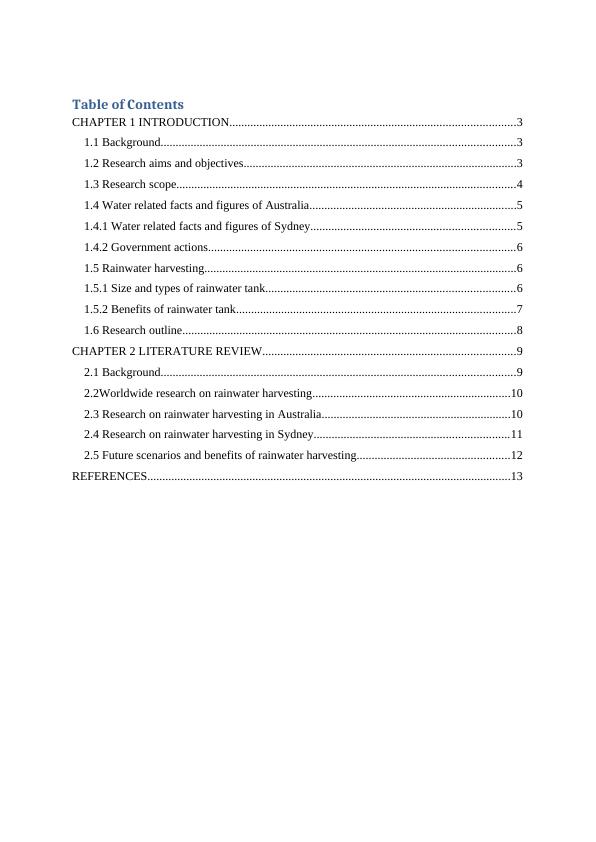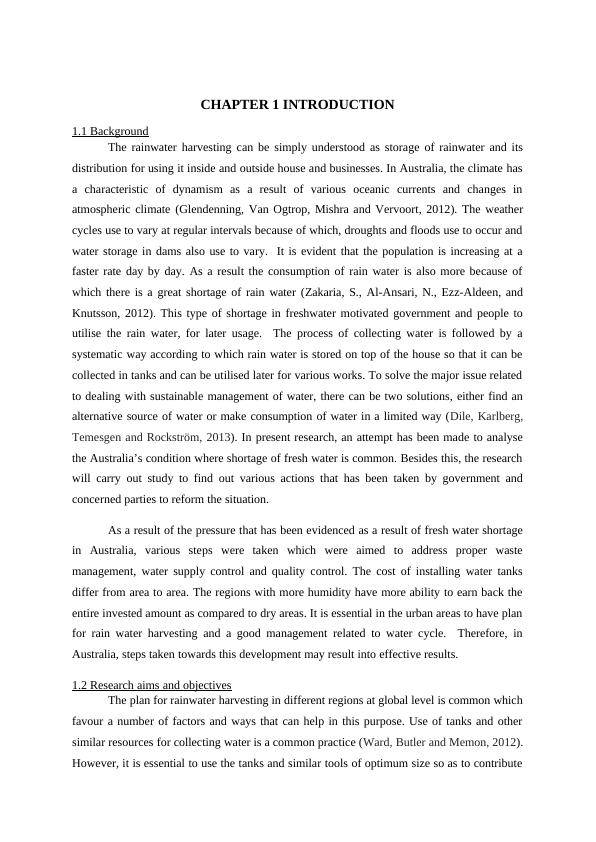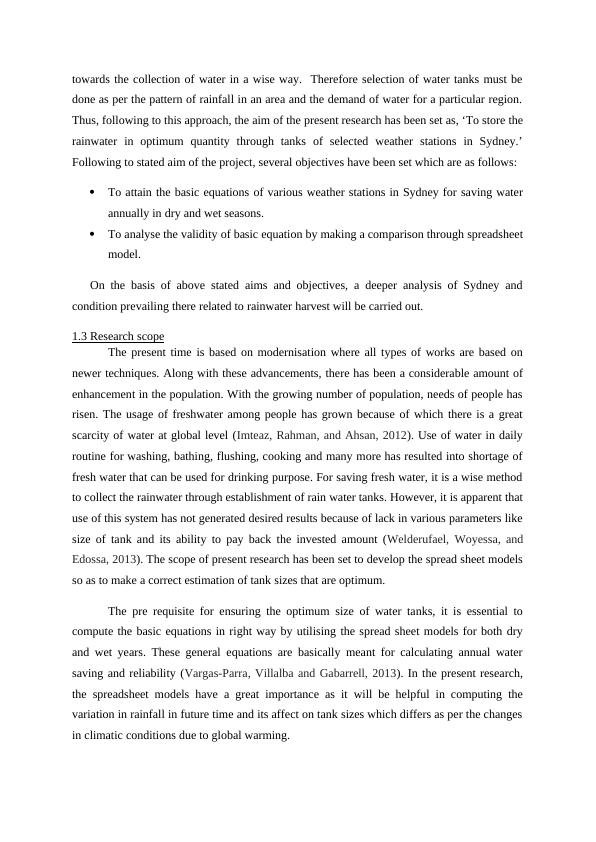Assignment on Rain Water Harvesting in Australia
Added on 2020-04-01
15 Pages5789 Words80 Views
RAINWATERHARVESTING

Table of ContentsCHAPTER 1 INTRODUCTION...............................................................................................31.1 Background......................................................................................................................31.2 Research aims and objectives...........................................................................................31.3 Research scope.................................................................................................................41.4 Water related facts and figures of Australia.....................................................................51.4.1 Water related facts and figures of Sydney....................................................................51.4.2 Government actions......................................................................................................61.5 Rainwater harvesting........................................................................................................61.5.1 Size and types of rainwater tank...................................................................................61.5.2 Benefits of rainwater tank.............................................................................................71.6 Research outline...............................................................................................................8CHAPTER 2 LITERATURE REVIEW....................................................................................92.1 Background......................................................................................................................92.2Worldwide research on rainwater harvesting..................................................................102.3 Research on rainwater harvesting in Australia...............................................................102.4 Research on rainwater harvesting in Sydney.................................................................112.5 Future scenarios and benefits of rainwater harvesting...................................................12REFERENCES.........................................................................................................................13

CHAPTER 1 INTRODUCTION1.1 BackgroundThe rainwater harvesting can be simply understood as storage of rainwater and itsdistribution for using it inside and outside house and businesses. In Australia, the climate hasa characteristic of dynamism as a result of various oceanic currents and changes inatmospheric climate (Glendenning, Van Ogtrop, Mishra and Vervoort, 2012). The weathercycles use to vary at regular intervals because of which, droughts and floods use to occur andwater storage in dams also use to vary. It is evident that the population is increasing at afaster rate day by day. As a result the consumption of rain water is also more because ofwhich there is a great shortage of rain water (Zakaria, S., Al-Ansari, N., Ezz-Aldeen, andKnutsson, 2012). This type of shortage in freshwater motivated government and people toutilise the rain water, for later usage. The process of collecting water is followed by asystematic way according to which rain water is stored on top of the house so that it can becollected in tanks and can be utilised later for various works. To solve the major issue relatedto dealing with sustainable management of water, there can be two solutions, either find analternative source of water or make consumption of water in a limited way (Dile, Karlberg,Temesgen and Rockström, 2013). In present research, an attempt has been made to analysethe Australia’s condition where shortage of fresh water is common. Besides this, the researchwill carry out study to find out various actions that has been taken by government andconcerned parties to reform the situation. As a result of the pressure that has been evidenced as a result of fresh water shortagein Australia, various steps were taken which were aimed to address proper wastemanagement, water supply control and quality control. The cost of installing water tanksdiffer from area to area. The regions with more humidity have more ability to earn back theentire invested amount as compared to dry areas. It is essential in the urban areas to have planfor rain water harvesting and a good management related to water cycle. Therefore, inAustralia, steps taken towards this development may result into effective results. 1.2 Research aims and objectivesThe plan for rainwater harvesting in different regions at global level is common whichfavour a number of factors and ways that can help in this purpose. Use of tanks and othersimilar resources for collecting water is a common practice (Ward, Butler and Memon, 2012).However, it is essential to use the tanks and similar tools of optimum size so as to contribute

towards the collection of water in a wise way. Therefore selection of water tanks must bedone as per the pattern of rainfall in an area and the demand of water for a particular region.Thus, following to this approach, the aim of the present research has been set as, ‘To store therainwater in optimum quantity through tanks of selected weather stations in Sydney.’Following to stated aim of the project, several objectives have been set which are as follows:To attain the basic equations of various weather stations in Sydney for saving waterannually in dry and wet seasons.To analyse the validity of basic equation by making a comparison through spreadsheetmodel.On the basis of above stated aims and objectives, a deeper analysis of Sydney andcondition prevailing there related to rainwater harvest will be carried out. 1.3 Research scopeThe present time is based on modernisation where all types of works are based onnewer techniques. Along with these advancements, there has been a considerable amount ofenhancement in the population. With the growing number of population, needs of people hasrisen. The usage of freshwater among people has grown because of which there is a greatscarcity of water at global level (Imteaz, Rahman, and Ahsan, 2012). Use of water in dailyroutine for washing, bathing, flushing, cooking and many more has resulted into shortage offresh water that can be used for drinking purpose. For saving fresh water, it is a wise methodto collect the rainwater through establishment of rain water tanks. However, it is apparent thatuse of this system has not generated desired results because of lack in various parameters likesize of tank and its ability to pay back the invested amount (Welderufael, Woyessa, andEdossa, 2013). The scope of present research has been set to develop the spread sheet modelsso as to make a correct estimation of tank sizes that are optimum.The pre requisite for ensuring the optimum size of water tanks, it is essential tocompute the basic equations in right way by utilising the spread sheet models for both dryand wet years. These general equations are basically meant for calculating annual watersaving and reliability (Vargas-Parra, Villalba and Gabarrell, 2013). In the present research,the spreadsheet models have a great importance as it will be helpful in computing thevariation in rainfall in future time and its affect on tank sizes which differs as per the changesin climatic conditions due to global warming.

End of preview
Want to access all the pages? Upload your documents or become a member.
Related Documents
Household Rain Water Tank Serviceslg...
|33
|8151
|50
Effect of Climate Change on Rainwater Tanks Savings in Sydney, Australialg...
|16
|1000
|76
Design of a Water Supply System for Mudgee Based on Ground Water and Rainwater Harvestinglg...
|27
|4879
|385
Rainwater Harvesting in Sydney, Australialg...
|41
|14377
|97
Investigating the Potentials of Rainwater Harvesting System in Melbourne and Adelaidelg...
|41
|11705
|87
Design of a Water Supply System for Mudgee in New South Wales, Australialg...
|21
|4217
|190
